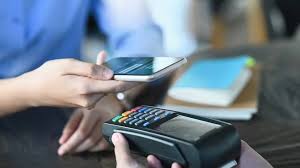Near-field communication (NFC) is essential to mobile payments, not merely a trendy term in the payments industry. Businesses may improve customer experiences by speeding up checkout times and accepting payments everywhere thanks to NFC mobile payment technology. NFC mobile payments are contactless transactions that transmit data between readers and payment devices, especially, tap-to-pay credit and debit cards or smartphone e-wallets like Apple Pay and Google Pay.
NFC payments, often known as “Tap to Pay” or “Tap” transactions, are quite popular since they are secure, contactless, and encrypted. Also, they can hasten the checkout procedure. You require a specific card reader in order to accept NFC mobile payments. How does NFC technology operate, though? And how can you use it for your company? You will discover all of this information in this article.
NFC Payment
The technology known as NFC (near field communication) enables two devices, such as your phone and a payment terminal, to communicate with one another while they are in close proximity. NFC is a technology that enables contactless payments.
NFC payments occur when a mobile wallet or an equipped credit or debit card interfaces with a payment terminal, delivering encrypted payment information from the customer to the shop. These mobile payments are increasingly ubiquitous since mobile wallets are more widely used than before. Consumers who desire an extra degree of convenience and security can use Apple Pay and Google Pay on their mobile devices at merchants whose point-of-sale systems offer tap-to-pay with cards and mobile payments.
More tap-to-pay cards are issued, and banks are sending replacement cards by default equipped with this feature when older cards expire. Cards that support this feature have a symbol that resembles an upside-down Wlan icon on them. Customers can pay (touch-free) using their phone, smartwatch, credit card, or tablet by using an NFC-enabled card reader. You can also accept contactless payments without a point of sale (pos) or card reader by using other NFC-enabled devices, such as an iPhone or an NFC-capable Android tablet. For a wide range of enterprises, including masonry retailers, e-commerce companies, and other service providers, NFC mobile payments provide a great payment option. Transaction fees for NFC payments typically resemble credit card processing charges and consist of a small portion of the purchase price plus a few cents per transaction.
How to Use NFC Payment
It is important for you to learn how to use NFC as a customer and as a business owner. One is that it’s always a good idea to stay informed on the direction that the payments sector is taking. Also, it will assist you in resolving any difficulties your consumers may encounter when attempting to pay with their device.
It’s not difficult to set up your phone to accept payments. The majority of mobile wallets read your credit card’s details using the camera on your phone (which, as we mentioned above, becomes encrypted). You can also synchronize your iTunes billing information if you have an iPhone and want to use Apple Pay.
Step 1: Verify that your phone complies with software requirements
Verify the Play Protect certification of your phone’s OS.
Make sure your phone satisfies security requirements if you modified it. Google pay may not function on devices that run developer versions of android at stores. Have factory software that has been modified by running a custom ROM, and rooted. Some phones cannot use Google Pay due to security concerns.
The bootloader is unlocked.
Reset your phone to factory settings to resolve these problems, with the exception of Play Protect certification and rooted devices.
Step 2: Check your phone’s settings to see if NFC is enabled.
Enter “NFC” in the “Search settings” field. Touch to activate NFC.
If NFC is not found in your phone, then it can’t perform contactless payments.
NFC Payment Mobile
For the purpose of transmitting payment information, two NFC-enabled devices are brought together in close proximity to one another using near-field communication technology. The two-way encryption used in NFC mobile payments is a crucial distinction since it makes this method of payment more secure than inserting or swiping a credit or debit card.
As the card information is delivered to the payment terminal, it is encrypted. Moreover, the mobile device needs to be authorized using a passcode, face ID, or fingerprint. Once the transaction has been verified, the NFC terminal relays the transaction details along with a randomly generated one-time use code that is given to the merchant rather than the customer’s debit card. Hackers cannot access the card information provided, and the one-time code used to deliver the encrypted payment information cannot be used more than once. NFC payments do not occur unintentionally and are challenging to hack because they require very close proximity to the terminal and biometric or multi-factor verification to proceed with the transaction.
You require an NFC-enabled card reader or another NFC-enabled device, such as an iPhone, in order to accept contactless NFC mobile payments. A short-range wireless technology swiftly sends data between the two devices to process the payment when a consumer holds their smartphone with a digital wallet app installed or an EMV chip card close to the payment device (within about two inches).
App for NFC Payment
These apps are digital contactless apps that enable rapid communication between your smartphones, tablets, or credit cards and NFC-enabled devices. Many businesses, including cafés and merchants, can benefit greatly from using this payment processing technology. Eateries, stores, and other businesses can take part in new product development to evaluate how it will affect their operations. Before embracing any new product, the firm must go through new product development stages to make sure it has thought everything through.
Mobile payments made using NFC require NFC-capable readers. A point of sale (POS) system initiates the trigger for an NFC-enabled reading device. It sends out a signal to look for a payment device with NFC capabilities. The reader will pick up the antenna of the NFC-enabled device and send the data to it. The payment is finally processed.
You should think about which contactless payment app works best for you if you want to stay on top of the whole trend. When choosing one, be sure to carefully examine their usability, credit card costs, and security features as they can differ.
#1. Google Pay
Most individuals can use this personal banking system. It enables secure transaction processing and is optimized for Android mobile devices. For Android and iOS mobile devices, Gmail makes it simple to send and receive money. On any device, Gmail enables secure transactions. Moreover, it revokes the user’s Google Account access.
You can use Google Pay to make purchases from any of the many physical stores that accept NFC contactless payments. The app will open when you click the Google Pay terminal to carry out the transaction.
#2. Apple Pay
Given Apple’s dominance in the smartphone industry, it’s not surprising to see Apple Pay on this list of contactless payment apps for Visa. All types of bank cards can be used and linked to Apple Pay, allowing you to rapidly open the app with a single touch gesture at the cash register. As an extra bonus, you can now connect your desktop Mac to Apple Pay and use the same mechanism for making online payments.
Your iPhone needs to be locked using Touch ID and a password in order to enable Apple Pay. Touch ID can be used to authorize payments as well. If you need more security than the standard 4-digit PIN provides, you can use a 6-digit code. There is always a chance that you will misplace or lose your phone. Turn “Find My iPhone” on to stop this from happening. You’ll be able to disable Lost mode using this.
#3. Square Wallet
Both iOS and Android devices are compatible with Square Wallet. It does have some extra features, though. Despite the fact that Square Wallet supports Mastercard connections, the software only accepts merchant cards for payment. Such is the operation of Square Wallet. Due to the area-based nature of this application, the retailer will be aware of your request and charge the card to your Square account.
#4. Samsung Pay
Only Samsung phones are compatible with Samsung Pay. Given that it is compatible with all payment kiosks, this option is only available for Google Pay. The information on your card’s magnetic stripe is transmitted to a terminal using this technology’s MST (Magnetic Safe Transmission) technology. This approach is typical. Moreover, it supports NFC and simultaneously transfers data through both.
#5. Cash App
Cash App is a payment software offered by the fintech behemoth Square that enables you to attach your debit card or even make purchases or transactions using Bitcoin as a form of payment. The app, like Apple and Google Pay, maintains a balance distinct from your primary bank account, and debits are subtracted from this balance. Cash App makes it simple to transfer and receive money. You will save a ton of money on transfer fees by doing this. Make a $ cash tag and use it to send payments. You can use your Cash App balance to make purchases offline or online. It is simpler because it can be used with Google Pay or Apple Pay.
#6. Zelle
You can send money with Zelle by using your bank account. The greatest option for American bank transfers, however, is Zelle. Use your phone number or email address to create an account, then connect it to your bank account. Whatever bank you use is completely up to you as long as you have a U.S. bank account. You can use your banking applications to transmit money or use the Zelle app. Enter the amount you want to send next. Nothing could be simpler.
What Is an NFC Payment?
Near Field Communication is an abbreviation. Using their smartphones and NFC technology, users may securely send and receive information over a short distance. NFC, an advancement over RFID, combines the reader and smartcard interface.
How Can I Use NFC to Pay?
Buyers can use a physical card with NFC technology embedded to conduct in-person purchases. By inserting or tapping the card against an NFC-enabled payment terminal, they complete the transaction, and the terminal obtains their payment data. This technology is also utilized in keycards, Salisbury steak, library cards, and passcodes.
How Do I Get NFC on My Phone?
Certain phones may be NFC-capable yet not have the feature enabled. Check the settings > connections > tap NFC and contactless payments > tap the switch to turn NFC on if you have a Samsung Android phone. After your device has this enabled, you can change the contactless payment settings and choose your favorite mobile payment provider, such as Google Pay or Samsung Pay.
What Is NFC on Phone?
NFC is a group of short-range wireless technologies that normally require a connection to be established. Between an NFC tag and an Android-powered smartphone, or between two Android-powered devices, NFC enables the sharing of tiny data payloads.
How Do I Know if My Phone Has NFC?
Every Android smartphone running Android 4.4 or higher is supported by NFC. (Your device would have NFC if you had access to Google or Samsung Pay.) You can check to see if your phone supports NFC by opening the HotSpot app, selecting the “Parking” menu, selecting the “Gate” tab, and then selecting the “Use Tap” button. You will know you have NFC capability if your phone screen changes and displays “Ready to Scan.” If your phone gives an error message that states “Your phone is not equipped with NFC capabilities,” this indicates you do not have the ability to scan in or out of the gated lots.
Another approach to determining if your phone has NFC capability is to access your settings to see if your phone has NFC capability (usually, you can swipe down from the top of your screen and find the gear icon).
Typically, a search bar will be located at the top; once selected, type “NFC” into the search bar to access the NFC settings. To activate NFC, you might need to click the button next to it. Try it is essential to take several precautions to guarantee client safety. In addition to the security advantages, merchants can highlight the hygiene advantages of not physically handling a payment terminal while promoting this feature in stores.
Do All Android Phones Have NFC?
Not all Android phones have the NFC category settings in their configuration. You should check for NFC in your phone’s settings; if you don’t see it, then that means that it is not compatible with your device.
Conclusion
Customers will increasingly adopt contactless payments as they learn about how quick, easy, and secure NFC payments are. It is essential to take several precautions to guarantee client safety. In addition to the security advantages, merchants can highlight the hygiene advantages of not physically handling a payment terminal while promoting this feature in stores.
Related Articles
- MOBILE WALLET: Best Mobile Wallets & How to Use It
- How to Work a Cash Register in 2023: Best Practices.
- Trust Wallet Review 2023: Is Trust Wallet Safe? (Updated!!!)






